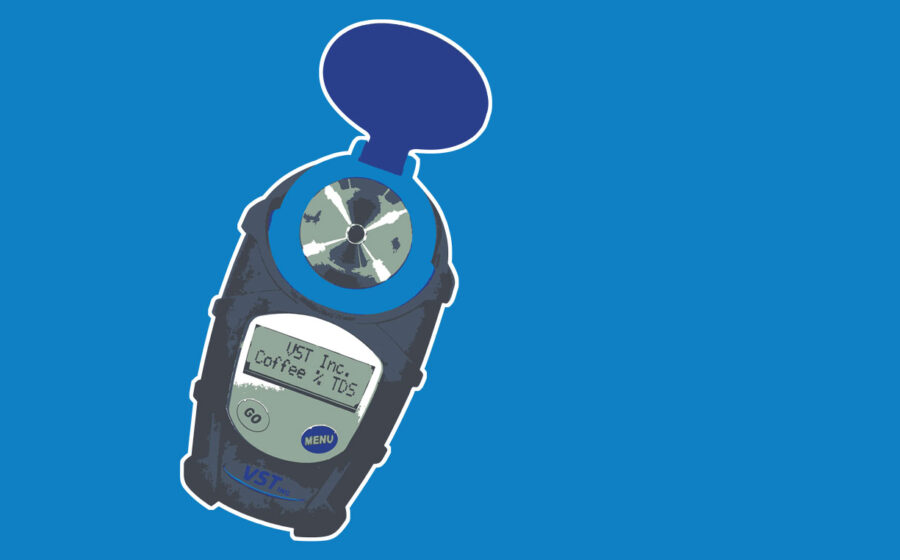[O]f all the tools in a barista’s utility belt, should a refractometer be one of them? Designed to measure the angle of light’s refraction through a liquid, refractometers are commonly used in laboratory settings to test things like the concentration of plasma protein in blood or to identify the materials in a gemstone. While coffee might not be considered as precious as blood or diamonds (to some, anyway), refractometers can also be used to measure concentration and calculate extraction yield in coffee.
VST, a tech-development company owned by coffee obsessive Vince Fedele, developed the first coffee-specific refractometer by building upon existing refractometer technology, which measures the temperature and the refraction of light in a liquid sample.* While a Brix refractometer can be used, they tend to be less accurate and require more calculations, which is why perhaps even more important than Fedele’s invention of the refractometer device itself is the accompanying software, VST CoffeeTools. Together they make a highly useable and easy-to-understand system that is becoming more commonly used in roasteries, beverage R&D departments for large retail companies, cupping labs, and, increasingly, coffee shops.
As with any technology, the equipment is at its most useful in tandem with the barista tools nature gave us: our palates and our critical-thinking brains.
To use VST’s coffee refractometer, a few drops of brewed coffee or espresso—the latter pressed through a special mesh filter, to remove some of the solid particulate that would affect the meter’s reading—is placed on the tool’s sample well, through which shines a beam of light. The refractometer then provides a measurement of the percent total dissolved solids. That TDS information, along with the brewing recipe used (coffee and water, by weight or volume) and final beverage amount gets plugged into VST CoffeeTools, which then calculates and plots the TDS and extraction yield of the brew. With both the design target and the resulting measurements plotted, the user can see how far and in what direction to make corrections, if necessary, along with their palate preferences to dial in final adjustments.
Phew! That’s as much of a mouthful as the espresso itself.
VST CoffeeTools is available for Windows, Apple, and Android devices, which means any coffee professional with the refractometer and a smartphone can measure the TDS and extraction yield of a brew on the fly. If they can afford the kit, that is: VST CoffeeTools on its own starts at $29–49 for mobile download versions and runs up to $149 for computer versions that provide full charting and allow in-depth design and analysis. The cost of a refractometer bundle with all accessories and VST CoffeeTools software as a complete system is $799, not necessarily practical for the average shot-slinger or Chemex brewer.
There’s good reason for baristas’ interest in these devices, however, as we all collectively pursue the perfect cup. While there might not be one “perfect cup,” it has become accepted that there are objectively better brews than others. Beginning with the results of a 1950s study conducted by MIT professor and Coffee Brewing Institute research director E.E. Lockhart, and confirmed in successive studies by the Midwest Research Institute the NCA, and other coffee-focused organizations, it’s been determined that most people prefer their brewed coffee extracted between eighteen and twenty-two percent yield, with a finished concentration of 1.15 to 1.35 percent TDS. (Espresso’s concentration is much higher—typically closer to nine or ten percent TDS, at similar extraction yields.)
The data this refractometer provides can be extremely useful when trying to dial in or evaluate a new coffee. It can show by the numbers whether a coffee is too strong or weak, and VST CoffeeTools can then use that information to determine whether it’s also over- or underextracted, which would allow a barista to diagnose problems with the brew itself. As with any technology, the equipment is at its most useful in tandem with the barista tools nature gave us: our palates and our critical-thinking brains. After all, while a refractometer can tell you how much you’ve extracted from the coffee grounds, it can’t tell you what you’ve extracted—or what that finished cup tastes like, good or bad. Unless the barista using these tools can reliably diagnose off flavors—underextraction’s overwhelmingly sour flavor and overextraction’s profound bitterness—the numbers themselves are somewhat meaningless.
When a coffee menu changes, spending a few minutes dialing in new varieties or origins with the help of this refractometer can speed the recipe process along. Does this Kenyan need a finer or a coarser grind than the Guatemalan we just stopped serving? Or does the Kenyan simply taste better extracted a little less with a slightly stronger concentration? Taking down results and comparing the numbers with the actual flavors in the cup can be a boon to a barista and a real boost in quality, accuracy, and repeatability.
In conjunction with a finely tuned palate for tasting and troubleshooting, VST’s refractometer and VST CoffeeTools could quickly become the Batman and Robin of your café—an unstoppable duo fighting the crime of bad coffee, together.
—Erin Meister, better known as just Meister, is a writer and part of Counter Culture’s educational department in New York City.
*A previous version of this story misstated what the VST refractometer measures. It measures a liquids temperature and its refractive index. Return to paragraph.














